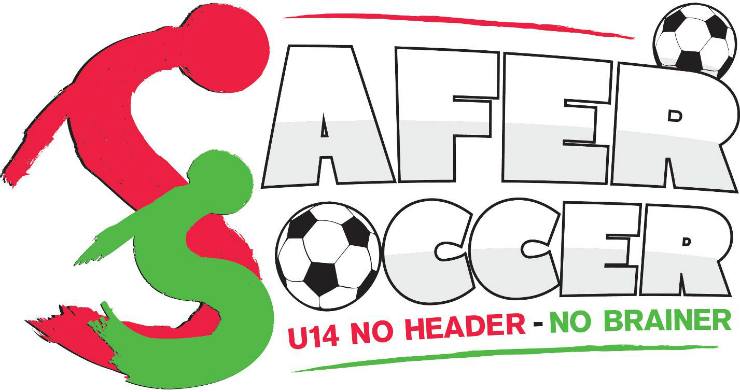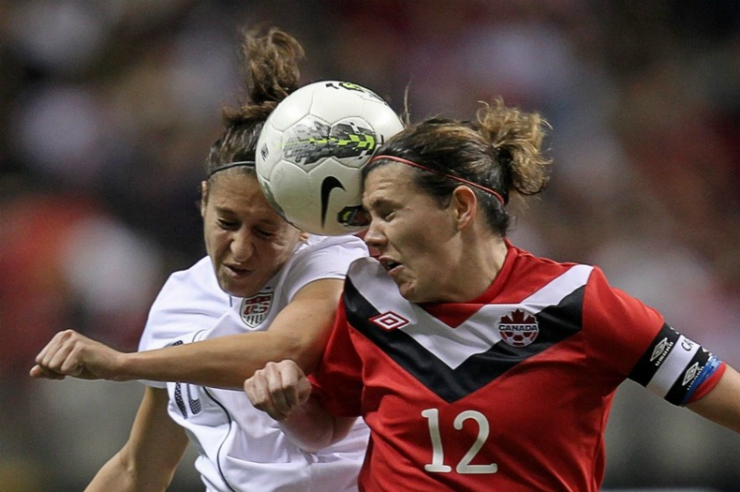Research Reveals Cause of Concussions And The Dangerous Effects – Banning Headers Will Not Stop Concussions in Soccer
Parents used to feel soccer was a safe youth sport …at least safer than football, with a lower risk of injuries. Now, parents are not so sure. Would our youth soccer players be safer and suffer less concussions if headers were banned? According to a new study on concussions and soccer — the answer is not as simple as everyone would like.
With the conclusion of the 2015 FIFA Women’s World Cup, soccer in America has gained significant momentum and an increase in popularity.
Concussions happen often – more often than we would want to admit. For example: “Morgan Brian turned onto her stomach and kicked the turf in pain. Red bloomed in Alexandra Popp’s blond hair like an excruciating carnation,” – as reported by the New York Times in After Heads Bang, Interests Collide for FIFA. The world watched as Hope Solo bent over her teammate Brian and tried to help her. After the collision, fans turn their attention back to the soccer action — and all too often those who suffer a concussion have a long and painful road ahead.
While the ’15ers were busy making history on the field, many soccer legends were busy promoting safe soccer in the media. Most notably, world champion and ’99er Brandi Chastain spread the news about the detrimental effects of headers for youth soccer players.
For some, the world’s favorite sport and heading the soccer ball seem to go together like peanut butter and jelly. However, as youth soccer continues to grow in the U.S., it is crucial that we look at the health disadvantages, such as concussions, found in the sport. New research shows that it is not always the impact of the soccer ball and the head colliding but the head-to-head crashes that cause the greatest concern.
In recent years, there has been significant research conducted to better understand the effects of concussions in all sports and especially youth soccer. The results have helped to create movements that aims to educate children, parents, & coaches about the dangers of headers and concussions. A new study published on JAMA Pediatrics reiterates the results of previous studies while concluding that rough play contributes more to concussions.
New Report – An Evidence-Based Discussion of Heading the Ball and Concussions in High School Soccer – Soccer, originally introduced as a safer sport for children and adolescents, has seen a rapid increase in popularity in the United States over the past 3 decades. Recently, concerns have been raised regarding the safety of soccer ball heading (when an athlete attempts to play the ball in the air with his or her head) given the rise in concussion rates, with some calling for a ban on heading among soccer players younger than 14 years. The report concludes that although heading is the most common activity associated with concussions, the most frequent mechanism was athlete-to-athlete contact.
A group of researchers at University of Colorado conducted a study looking at concussions in youth soccer—both boys and girls—to identify soccer related activities, like headers, that result in concussions. Data was collected for the past decade of over 1,000 high school boy’s and girl’s soccer athletes’ concussions. These concussions were sustained in soccer games and practices. The data demonstrated that girls suffered from more concussions compared to boys. This study concluded that headers caused 25.3% of girls’ concussions and 30.6% of boys’ concussions—supporting previous research that has been cited by those calling to ban headers in youth soccer.
If associations were to ban header, approximately 30% of concussions could be prevented—this amounts to roughly 100,000 concussions over 3 years. An improvement that would benefit many. However, headers contribute to only part of the problem according to the new study. Bottom line is we want our kids safe but to love the game of soccer.
The most frequent cause of concussions in youth soccer? Player-to-player contact.
Or in other words rough play – even accidental collisions caused by two players going for the same ball and attempting to head the ball and crashing into each other by mistake.
Contact between players accounted for 69% of concussions in boys and 51% concussions in girls. If rules and regulations were more accurately enforced, we would see an even larger decrease in youth soccer.
These findings bring something new to the debate on hand. There are many—both parents and coaches alike—that are attempting to ban headers until the high school level. But the researchers at the University of Colorado wanted to test these claims and see if they were valid. “A lot of people felt, if we could get a ban on heading, we could keep some people safe. My question was, is there any evidence out there that supports that,” said epidemiologist Dawn Comstock—Colorado School of Public Health.
 Comstock is referring to initiatives like Parents and Pros for Safer Soccer, a movement launched by Sports Legacy Institute (a concussion research and advocacy nonprofit) and the Santa Clara Institute of Sports Law and Ethics. Safer Soccer looks to educate parents and coaches on the risks of allowing kids to make headers before the high school level. World champion and soccer legend Brandi Chastain is a big advocate for Safer Soccer and has brought the issue to the media and her social media sites to eliminate headers in youth soccer until the high school level (14 years old).
Comstock is referring to initiatives like Parents and Pros for Safer Soccer, a movement launched by Sports Legacy Institute (a concussion research and advocacy nonprofit) and the Santa Clara Institute of Sports Law and Ethics. Safer Soccer looks to educate parents and coaches on the risks of allowing kids to make headers before the high school level. World champion and soccer legend Brandi Chastain is a big advocate for Safer Soccer and has brought the issue to the media and her social media sites to eliminate headers in youth soccer until the high school level (14 years old).
On their website, Safer Soccer states that headers are the cause of about 30% concussions and offers readers the chance to peruse through the research done by experts in this field. This statistic is similar to those of the newly published study by Comstock and co. However, Comstock expands the question to look at causes of concussions beyond headers. By doing so, they were able to conclude that player-player contact was one of the more frequent means through which concussions were sustained—affirming what previous studies had concluded. Research conducted by Nationwide Children’s Hospital on youth sports and concussions found that player-player contact accounted for over 70% of concussions.
With these results, Comstock has raised questions concerning the validity of banning headers until the high school level. Co-author Sarah Fields seems to agree in saying, “I don’t see how banning heading for a 12-year-old makes a 15-year-old any safer.” Age 14 is a common dividing point in youth soccer, but is it a good cutoff point for something like concussion prevention? Why age 14/high school level?
Co-founder of Sports Legacy Institute (SLI) Robert Cantu agrees that a “perfect” cutoff date may not exist. However, the reasoning behind this cutoff lies in neuroscience. Headers are particularly dangerous because of the brain damage that results from contact with the ball. At a young age when the brain is not fully developed, repetitive brain damage is very detrimental. Additionally, these young players don’t have as strong of a neck as professional athletes, increasing the risk of concussions for these children. A stronger neck may help reduce this risk because it decreases the the head acceleration caused by the impact with the ball.
Cantu and supporters argue rather than allowing contact between the ball and the head, coaches should focus on working on the young soccer player’s coordination and movement—a move that both Chastain and Parlow Cone, former head coach of the Portland Thorns FC, support.
“With good coaching, heading skills can be learned during the high school years. Up until the high school age, the focus should be on coordination, technical skills and spatial awareness,” said Cone. “Delaying the teaching of heading skills, while still preparing players for heading by teaching jumping and landing and strengthening the neck, not only will help make the sport safer but also is developmentally appropriate.”
Brandi Chastain agrees that “the benefits of developing heading skills as children are not worth the thousands of additional concussions that youth soccer players will suffer.”
Knowing now the results of the new published study, where do we go? Do we put into effect what the leaders of Safer Soccer call for: banning headers until age 14? Or do we look at Comstock and co’s research more closely and focus on reducing rough play in soccer? Comstock calls for the latter and thinks it would be beneficial to look at the research in more detail. There are many products available – such as Full90 headgear – which has been designed to mitigate the typical impact forces that occur in soccer. HALO™ Headgear is another headband type option that absorbs and disperses impact forces away from the head and is worn by Ali Krieger of the US Women’s Soccer Team.
If research has concluded that rough play is a bigger factor in youth soccer concussions, then perhaps we ought to work harder to enforce the rules and regulations. Current soccer guidelines recommend introducing headers at the age of 13, however evidently this isn’t strictly enforced.

Perhaps while we wait to see if youth soccer associations will side with movements like Safer Soccer, we ought to push for a stricter enforcement of the regulations and rules to reduce rough play among younger players. Parents should encourage the use of protective head gear, as worn by members of the U.S. Women’s National Team. By doing so, these young athletes can continue to play the sport they love, but in a safer manner.
RELATED ARTICLE: NO MORE HEADERS






